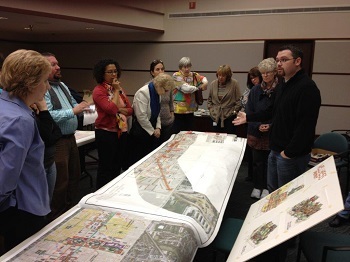Sustainability has become a watchword in philanthropy, as funders seek to answer a fundamental question: How best to invest in projects that will continue to provide benefits long after the initial funding has been spent? Foundations, government agencies, corporate giving programs, social venture groups, and individual philanthropists are working to ensure that, when they make a grant, it includes ideas, structures, and often, partnerships to help ensure that the supported work will last.
Funding sustainable age-friendly community work
A good example of this kind of sustainable grantmaking can be found in the field of age-friendly community development. An age-friendly community is a great place to grow up and grow old.
An age-friendly community supports the mobility, productivity, and health and well-being of citizens of all ages by prioritizing accessible transportation, affordable housing, safe outdoor spaces, quality community and health services, employment and volunteer opportunities, and engaging social activities. Grants to support this type of work may fund infrastructure changes and improvements, new or better aligned social services, support for grassroots neighbor-to-neighbor efforts, or urban and regional planning work.
During the last decade, the age-friendly movement has grown significantly both here and abroad, generating a vibrant network of cities and communities, numerous useful models of action, and a wide variety of supportive resources. Creating places that will continue to be great to grow up and grow old, however, requires sustained investment that extends well beyond traditional philanthropic support, one-off government funding, and modest volunteer contributions.
Building a sustainability framework
To build on the movement's successes to date and accelerate sustainable progress, Grantmakers In Aging (GIA), the only national association of funders focused on improving the experience of aging, recently brought together national and international leaders in the age-friendly communities movement. Over the course of a year, age-friendly funders and practitioners worked together to explore what works and how to sustain it, using a combination of focus groups, key informant interviews, hands-on experience, and discussions at a two-day leadership summit.
Best practices and success stories from that work have now been distilled into a framework document: Guiding Principles for the Sustainability of Age-Friendly Community Efforts. The focus on sustainability and the creation of this framework were among several important outcomes of Community AGEnda, a three-year initiative to increase age-friendly activities that GIA led with support from the Pfizer Foundation.
Elements of sustainability
Definitions of sustainability vary widely, but in the philanthropy and community development context, the term is often a proxy for funding. All the same, sustaining age-friendly efforts will require support that goes well beyond financial support. It must also include:
Public will
Building public will for age-friendly efforts is at the very heart of sustainability, but such support doesn't happen spontaneously. Sustainable age-friendly efforts must connect with people in the community, identify and develop champions, then help focus and amplify those voices. Age-friendly advocates must also make an active effort to learn about community needs, and inform others about how their age-friendly initiatives serve people of all ages.
Age-friendly communities provide benefits to the broader community, including real economic impact in arenas such as community development, housing, employment, services, and retail, and real service improvements in arenas like transportation. Exploring and articulating how this work benefits others helps provide a persuasive rationale and motivation for members of the public to join in the work.
Cross-sector engagement 
Traditionally, programs for older adults fall within the purview of the aging services sector, but successful age-friendly programs generally operate both in and beyond that sector. Developing a healthy and supportive community for all ages requires involvement and commitment from a wide range of sectors, including municipal planning, public health, arts and culture, parks and recreation, government, business, housing, industry, the faith community, environment, technology, health care, and grassroots organizations.
Persuasive metrics
The right metrics can help demonstrate the need for an age-friendly initiative, document its impact, and build its long-term credibility. Collecting and analyzing this data, then sharing it with key stakeholders such as funders, community residents and leaders, and elected officials can build a program's sustainability. The right metrics will generally combine quantitative data with qualitative data, such as focus group or key informant interviews, and even personal stories.
A range of resources
Securing resources from traditional sources, such as foundations or private philanthropy, or even one-time grants from government, is generally necessary to launch an age-friendly initiative or add a new project to an existing effort. Similarly, in-kind contributions can help get age-friendly initiatives started and expand capacity. Ultimately, however, age-friendly initiatives must develop the ability to influence or shape existing private sector and government spending. This is especially important in environments where new funding opportunities are limited.
Public policies and planning 
While short-term projects demonstrate the value of age-friendly strategies, lasting change occurs when age-friendly principles are embedded in or expressed through local, regional, state and federal policies, practices, and plans. When developing an age-friendly project, it is important to think from the beginning about possible sources of longer-term, generally government, funding.
This can include legislative and appropriated dollars obtained through local, regional, state, and federal sources, as well as new bond levies, re-oriented appropriations from government agencies, age-friendly or livability regulations (e.g., Complete Streets), and mixed-used zoning designations. By attending planning meetings, suggesting age-friendly wording, and offering initiatives that will support older adults, advocates can get age-friendly policies and goals embedded in a wide variety of programs and initiatives, including municipal, regional, state, and federal planning documents.
Creating age-friendly communities is a long-term process that requires collaboration and partnerships, all of which take time and are frequently complex and challenging. Yet the effort is well worthwhile. The path will be different for each community, but progress on any of the sustainability principles presented here will help advance the work of making all communities great places to grow up and grow old.
This post was co-authored by Jennifer W. Campbell, PhD, MSW, a consultant to Grantmakers In Aging who also served as the program evaluator for GIA's Community AGEnda initiative.

